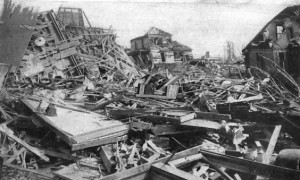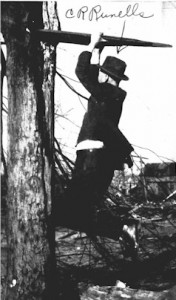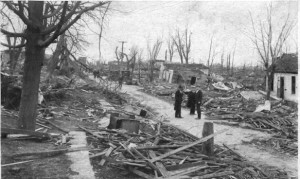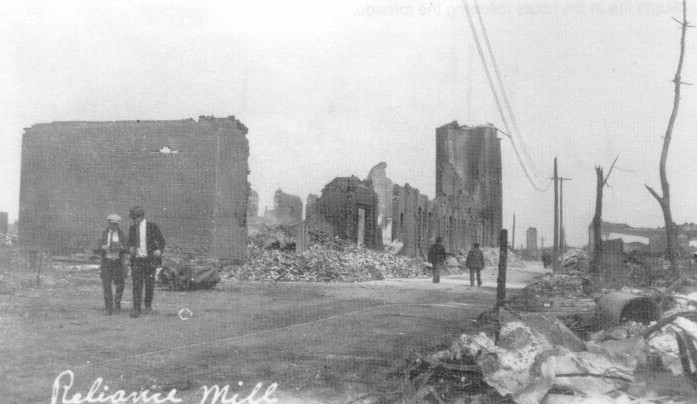Tri-State Tornado of 1925

Chicago’s “Herald Examiner” headline covering the Great Tri-State Tornado of 1925. Photo Credit: Wikipedia
All morning, before the tornado, it had rained. The day was dark and gloomy. The air was heavy. There was no wind. Then the drizzle increased. The heavens seemed to open, pouring down a flood. They day grew black…
Then the air was filled with 10,000 things. Boards, poles, cans, garments, stoves, whole sides of the little frame houses, in some cases the houses themselves, were picked up and smashed to earth. And living beings, too. A baby was blown from its mother’s arms. A cow, picked up by the wind, was hurled into the village restaurant.
– St. Louis Post-Dispatch, March 20, 1925

A map of the track of the 219-mile, 3.5 hour Tri-State Tornado which killed 695 in Missouri, Illinois, and Indiana on 18 March 1925. Photo Credit: Wikipedia
On Wednesday, March 18, 1925, the longest and deadliest tornado in U.S. history stuck the Midwest. Called the Great Tri-State Tornado, it started at 1:01 p.m. around Ellington, Missouri. It raged for three and a half hours, barreling through southern Illinois and Indiana before finally breaking up after hitting Princeton, Indiana. The 219 mile devastation path included three states, 19 communities, destroyed more than 15,000 homes, injured 2,027 people and leaving 695 dead.

Ruins of the Baptist Church at Murphysboro. A funeral was in progress when the tornado hit around 2:30 p.m. Photo Credit: NOAA
At the time, weather forecasters did not have the technology to predict, identify or even to track severe weather. In the Midwest, weather often changed quickly. The morning could be perfectly pleasantly sunny and a blizzard or, in this case, a tornado could occur in the afternoon. Cities had no tornado sirens to give warning. No weather interruptions on the radio. The tornado was moving too quickly to telephone anyone – if one even had a telephone. There was only one thing left for people to do – get down and brace themselves.
The forecast for that day called for showers and cooling temperatures. In the early afternoon the column of twisting air formed near Ellington, Missouri. A local farmer was killed as it moved east 70 mph with winds over 300 mph. Within 15 minutes the tornado struck Annapolis – destroying 90 percent of the town and killing 4 more people. It took a little over 80 minutes for the storm to move through the farmlands of rural eastern Missouri. It left around a dozen died. The worse was yet to come.
The twister moved into Illinois. It was said that the tornado followed a slight topographic ridge that a series of mining towns were built on. The town of Gorham, population 500, began getting pelted by hail. The wind quickly increased. Resident Judith Cox was having lunch in town at the time. To the St. Louis-Post Dispatch she later recalled, “There was a great roar. Like a train, but many, many times louder. ‘My God!’ I cried. ‘It’s a cyclone and it’s here.’ The air was full of everything, boards, branches of trees, garments, pans, stoves, all churning around together. I saw whole sides of houses rolling along near the ground.” Cox attempted to leave the restaurant but the strong winds blew her back inside. A cow came through the restaurant’s roof. The building collapsed, killing the cook. Cox, and the cow, were later pulled out alive. Also appearing in the St. Louis-Post Dispatch‘s March 20, 1925 edition, a Gorham schoolgirl gave her own harrowing account.
“Then the wind struck the school. The walls seemed to fall in, all around us. Then the floor at one end of the building gave way. We all slipped or slid in that direction. If it hadn’t been for the seats it would have been like sliding down a cellar door.
I can’t tell you what happened then. I can’t describe it. I can’t bear to think about it. Children all around me were cut and bleeding. They cried and screamed. It was something awful. I had to close my eyes…“

Ruins of the Murphysboro’s Longfellow School where 17 children were killed. The storm hit the school at about 2:30 p.m. Photo Credit: NOAA

Homes shattered to pieces in Murphysboro. Half the population was homeless. About 1,200 homes were completely destroyed in an area 1 mile wide and 2 ½ miles long. Photo Credit: Jackson County Historical Society/NOAA

Gentleman hanging from a piece of wood that was hurled into a tree by the tornado. Photo Credit: Jackson County Historical Society/NOAA
The tornado literally tore through the town. Every building was destroyed and 37 people were died. The tornado, now stretching almost one mile in diameter, had its sights on the rail hub city of Murphysboro situated 11 miles east.
Of all the communities the tornado stuck, Murphysboro had the most concentrated and extensive damage of all. Additionally, with the death total at 234, Murphysboro had the greatest number of tornado fatalities suffered by a single U.S. city during such a disaster. At the town’s Longfellow Grade School, children were trying to escape the building as it started collapsing. About half were still trapped and 17 children were killed. Whether it was the winds or the fires that came after, numerous blocks of homes, schools, business and churches were flattened leaving the 12,000 population in utter shock.
After three and a half hours and 219 miles of destruction, the Tri-State Tornado, the longest and deadliest in the United States, finally began to dissipate 10 miles northeast of Princeton. It left an estimated $16.5 million ($1.5 billion today) in damages. Even worse though was the number of casualties. In southern Illinois alone: 541 were killed while 1,423 were injuried in 40 minutes when the storm blew through Murphysboro, De Soto, Hurst-Bush and West Frankfort. It killed 69 children in nine schools.
The Red Cross and National Guards were called in to help in the recovery and cleanup. The National Guards also made rounds to discourage looting and other lawlessness that comes with disasters. Adlai E. Stevenson II, a 25-year-old Pantagraph reporter, rushed to Murphysboro. He wrote about the scene at railway station as he left to go to the city. “An atmosphere of catastrophe and havoc pervades all trains en route to the storm-stricken area. The train is carrying three cars of volunteer nurses and doctors, many of whom saw service on the muddy fields of Flanders [World War I battlefield] and know, without being told, something of what awaits them.” When he arrived at the destroyed town, Stevenson remarked that it was “a field of kindling and bricks over the face of a bleeding and smoking world.”

Residence district of Murphysboro where 154 city blocks were destroyed in the Tri-State Tornado of March 18, 1925. Photo Credit: Jackson County Historical Society/NOAA
The Red Cross established 13 relief centers and public donations poured in. “Many of the doctors have not taken off their aprons in 36 hours,” Stevenson wrote. “The few available hearses in Murphysboro are racing back and forth to the cemetery, carrying two caskets at a time, many of them small ones. Of formal funerals there are none, but of heroic fortitude there is much.”

Engineering committee examining a 1X5 inch board which was driven through a 2X6 plank. Photo Credit: NAOO
Tents were erected as temporary homes for those who had no where to go. Food and clothing were also distributed. Nurses and doctors gave out tetanus shots fearing the bacteria from the dirt would cause infections in the wounds.
Clean-up started almost immediately. Many of the towns planned to rebuild. Some towns had no one left to build a town for as was the case of Parrish, Illinois. The little town of 250 lost the majority of their population to either death or injuries. Their funerals were held in adjacent towns and most of the survivors moved away.
De Soto, Gorham and Griffin, Indiana were also virtually annihilated by the Tri-State Tornado. In Griffin, between 69-75 people were killed and 85 farms were destroyed. Of the 500 people who lived in De Soto, fewer than 200 were left uninjured. The survivors were resilient. On De Soto’s unsure future, one state senator stated that he would not give up on the town simply because, “My father is buried there.” De Soto, Gorham and Griffin all rebuilt.
In his writings about Murphysboro, Stevenson summed up the aftermath of the 1925 Tri-State Tornado best. “Viewing this broad expanse of scattered, twisted smoldering wreckage one cannot but reflect on the futility of life and the insignificance of man.”

After the storm, the Red Cross and other charitable organizations brought food, clothing and tents (shown above) for those in need. The National Guard assisted with the clean-up efforts and patrolled the streets to prevent looting, Murphysboro. Photo Credit: Jackson County Historical Society/NOAA

The destroyed building is of the Reliance Mill on North 17th Street, it was never rebuilt after the tornado. Photo Credit: Jackson County Historical Society/NOAA
Sources
John Galvin, “Tri-State Tornado: Missouri, Illinois, Indiana, March 1925,” Popular Mechanics, July 30, 2007.
Bill Kemp, “Adlai Stevenson II witness to 1925 tornado devastation,” Pantagraph, April 17, 2011.
Jon Henley, “Tornadoes can kill, and the Tri-State tornado was the deadliest of them all,” The Guardian, May 21, 2013.
TIME
NOAA (National Oceanic and Atmospheric Administration)
Red Cross










